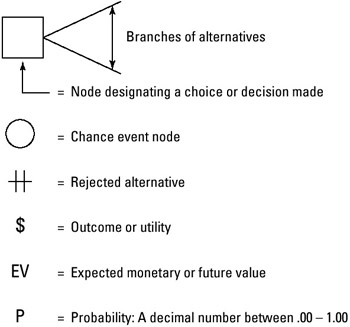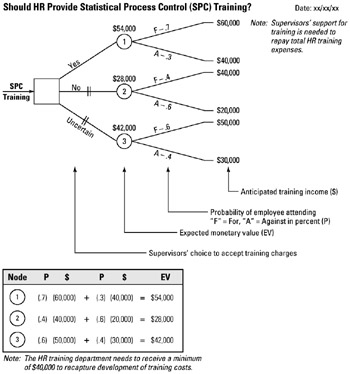Tool 59: Decision Tree Diagram
| AKA | Decision Flow Analysis |
| Classification | Decision Making (DM) |
Tool description
A decision tree diagram displays the outcomes or expected values of several possible alternatives and the likelihood, expressed as precent probability, of their happening. Restated, the diagram allows a manager or team to rationally analyze alternative branches and select the best possible choice of action or outcome (utility).
Typical application
-
To analyze all possible alternatives in a decision situation.
-
To assist the decision-making process.
-
To decide on a course of action by considering outcomes and probabilities in the analysis.
Problem-solving phase
| → | Select and define problem or opportunity |
| → | Identify and analyze causes or potential change |
| → | Develop and plan possible solutions or change |
| Implement and evaluate solution or change | |
| Measure and report solution or change results | |
| Recognize and reward team efforts |
Typically used by
| Research/statistics | |
| Creativity/innovation | |
| 4 | Engineering |
| 1 | Project management |
| Manufacturing | |
| Marketing/sales | |
| Administration/documentation | |
| Servicing/support | |
| 3 | Customer/quality metrics |
| 2 | Change management |
before
-
Tree Diagram
-
Consensus Decision Making
-
Influence Diagram
-
Relationship Map
-
Activity analysis
after
-
Action Plan
-
Opportunity Analysis
-
Potential Problem Analysis (PPA)
-
What-If Analysis
-
Risk Space Analysis
Notes and key points
Decision Tree Diagram Definitions and Symbols:
-
 Branches of alternatives
Branches of alternatives -
 = Node designating a choice or decision made
= Node designating a choice or decision made -
 = Chance event node
= Chance event node -
 = Rejected alternative
= Rejected alternative -
$ = Outcome or utility
-
EV = Expected monetary or future value
-
P = Probability: A decimal number between.00 - 1.00
-
Backward induction: The backward calculating of expected values (EV) needed to make a decision.
-
Probability values (.00 - 1.00) are usually based on prior experience or historical data.
-
It is recommended that the reader refer to any text on statistics for additional background information on probability and decision trees.
Step-by-step procedure
-
STEP 1 As a first step, the following information must be collected by the researcher in order to formulate a decision strategy for a particular concern, issue, or problem:
-
A clearly defined concern, issue, or problem statement.
-
The number and description of possible alternatives.
-
The percent chance (probability) for each particular event (branch).
-
The projected outcome (utility) for each possible branch. This is often based on historical data or experience.
See example Should Human Resources Provide Statistical Process Control (SPC) Training?
-
-
STEP 2 Once all data has been collected, a decision tree diagram is drawn, showing all alternatives and chance event branches.
-
STEP 3 Next, outcomes and probabilities values are placed next to each branch. In this example, dollar outcomes were forecasted revenues from operation supervisors to pay for their employees' training charges. Probabilities were based on the results of a student survey to check their interest in attending SPC training (F = for, A = against attending). The alternatives for supervisors (yes, no, or uncertain) were the normal choices supervisors had in managing their training budget.
-
STEP 4 The backward induction process calculations are estimated monetary values (EV) for nodes numbers 1–3. Calculations in this example are shown in the table associated with the decision tree.
-
STEP 5 On the basis of the calculations, node number 1, the alternative that reflects supervisory support for the SPC training, is considered the first choice. It also allows the HR training department to recapture training expenses for developing and conducting this training for employees.
-
STEP 6 Alternatives number 2 and number 3 are marked $$ to designate the risky and, therefore, rejected alternatives.
Should HR Provide Statistical Process Control (SPC) Training?

EAN: 2147483647
Pages: 326
- Chapter IV How Consumers Think About Interactive Aspects of Web Advertising
- Chapter VII Objective and Perceived Complexity and Their Impacts on Internet Communication
- Chapter VIII Personalization Systems and Their Deployment as Web Site Interface Design Decisions
- Chapter X Converting Browsers to Buyers: Key Considerations in Designing Business-to-Consumer Web Sites
- Chapter XVI Turning Web Surfers into Loyal Customers: Cognitive Lock-In Through Interface Design and Web Site Usability